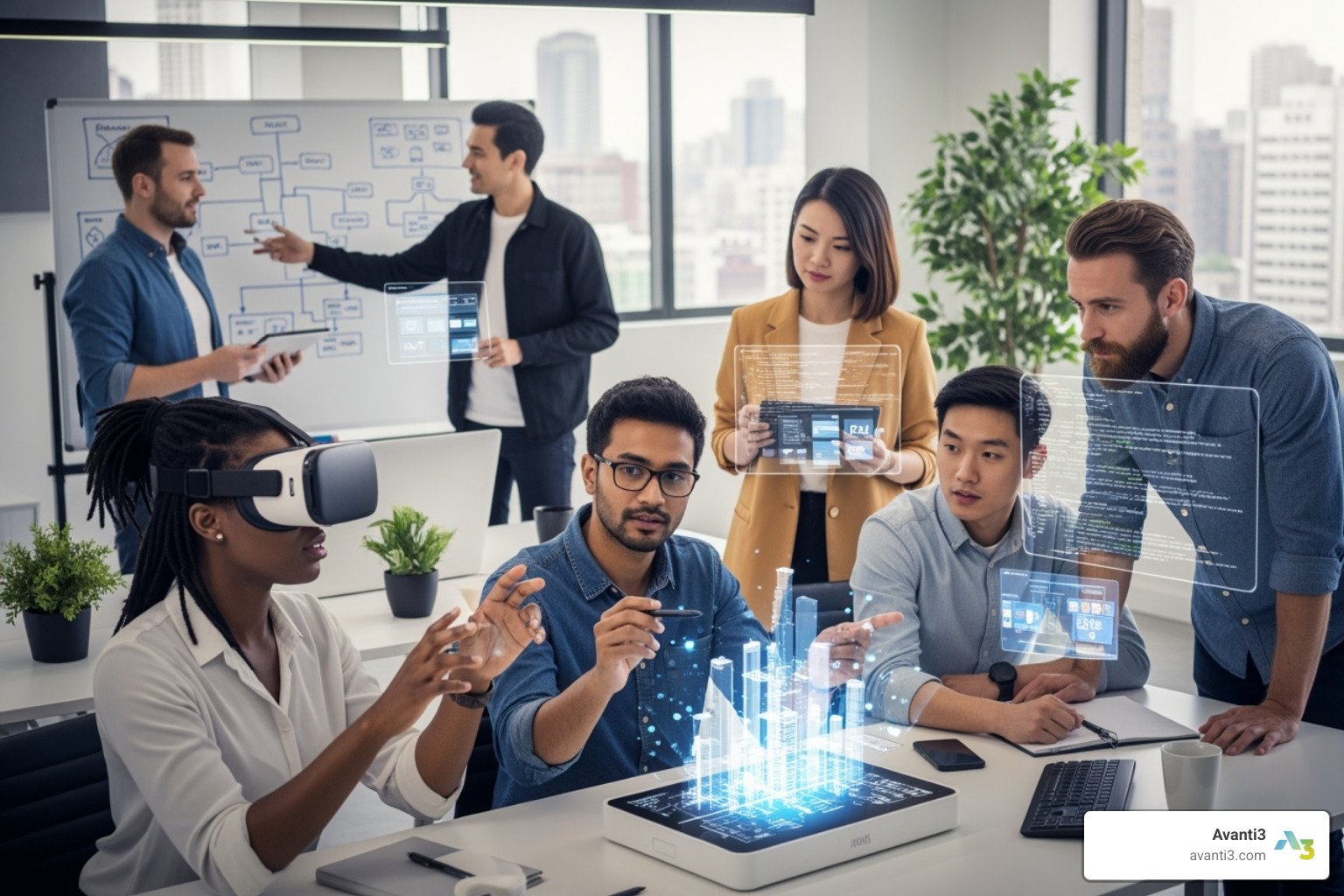AR VR Application Development Services: Top Experts 2025
Why AR VR Application Development Services Are Changing Digital Experiences
AR VR application development services are revolutionizing how businesses engage with customers and streamline operations by creating immersive experiences that blend the physical and virtual worlds. These services span from AR, VR, and MR development to custom app creation, cross-platform integration, 3D content creation, and strategic consulting.
The market data reveals impressive growth. Companies report sales increases of up to 20% with ‘try before you buy’ VR experiences, while VR training can reduce employee training time from nine weeks to just 15 days, saving millions.
As one industry expert noted: “With so many industries enjoying such dramatic success with AR and VR, it’s easy to get excited about what’s possible.”
The challenge lies in finding development partners who understand both the technical complexity and business applications of these technologies to deliver measurable impact.
I’m Samir ElKamouny AV, and I’ve helped numerous brands steer the landscape of AR VR application development services to build innovative engagement solutions. My experience has shown me which development approaches deliver real results.

Basic ar vr application development services vocab:
The Immersive Spectrum: Distinguishing AR, VR, and MR
Immersive technologies like AR, VR, and MR can seem complex, but they exist on a spectrum of immersion. Let’s clarify how each plays a unique role in shaping our digital future, from adding a digital layer to our world to creating entirely new virtual ones.

Augmented Reality (AR) Explained
Augmented Reality (AR) superimposes computer-generated images and data onto your real environment. Instead of taking you to a new place, it adds an interactive digital layer to the world you see. For example, you could use your phone to see how a new couch looks in your living room.
AR works in a few ways:
- Marker-based AR uses specific images like QR codes to trigger digital content.
- Markerless AR uses smart algorithms like SLAM (Simultaneous Localization and Mapping) to understand your environment, allowing you to place digital objects freely.
- WebAR delivers AR experiences through a web browser, with no app download required, making it highly accessible.
AR is versatile, enabling virtual try-ons in retail, in-store navigation, and personalized marketing. At Avanti3, we leverage these capabilities in our Augmented Reality Marketing solutions.
Virtual Reality (VR) Explained
If AR improves reality, Virtual Reality (VR) replaces it. VR immerses you in a simulated, 3D environment using a headset, completely blocking out the physical world. Key features include 360° video for panoramic views, room-scale VR for physical movement within a virtual space, and haptic feedback to add a sense of touch.
VR has revolutionized training by providing safe, risk-free environments for complex procedures, from surgery to flight simulation. It also enables immersive 3D house tours in real estate and creates captivating games and entertainment. We pride ourselves on crafting compelling Virtual Reality Experiences that leave a lasting impression.
Mixed Reality (MR) and Extended Reality (XR)
Mixed Reality (MR) blends the best of AR and VR, allowing digital content to interact with the real world in real-time. Unlike simple AR overlays, MR objects can understand and react to your physical environment. Imagine a holographic instruction manual that guides you through a complex repair on a physical machine.
Extended Reality (XR) is the umbrella term that covers AR, VR, and MR. It represents the entire spectrum of immersive technologies that bridge the gap between our real and virtual worlds.
Here’s a quick comparison:
| Feature | Augmented Reality (AR) | Virtual Reality (VR) | Mixed Reality (MR) |
|---|---|---|---|
| Immersion Level | Low to medium (overlays digital on real world) | High (fully replaces real world with digital) | Medium to high (blends digital and real, allowing interaction) |
| Interaction | Digital content interacts with real world, user views | User interacts with digital content within a virtual world | Digital content interacts with and responds to the real world; user interacts with both |
| Hardware | Smartphones, tablets, smart glasses (e.g., Google Glass) | VR headsets (e.g., Oculus Quest, HTC Vive, PlayStation VR) | MR headsets (e.g., Microsoft HoloLens, Magic Leap) |
| Key Use Cases | Navigation, gaming (Pokémon Go), virtual try-ons, remote assistance, product visualization | Training simulations, virtual tours, immersive gaming, virtual meetings, therapy | Collaborative design, remote maintenance, interactive education, complex simulations, real-time data visualization |
| Example | AR app showing furniture in your room | VR game where you explore a fantasy world | Holographic instructions guiding you through a complex repair on a physical machine |
How AR/VR Transforms Industries: Benefits and Use Cases
AR VR application development services are not just tech demos; they are fundamentally changing how industries operate by solving real problems and creating genuine value. Companies are seeing increased efficiency, improved safety, and significant cost reductions. These technologies excel at presenting complex information in digestible ways and making immersive training accessible. This is why we focus on creating impactful AR/VR Immersive Experiences for our clients.

Retail & E-commerce
Shopping is getting a major upgrade with AR/VR.
- Virtual try-on: Lets customers see how clothes, makeup, or glasses look on them, reducing returns.
- AR product visualization: Allows shoppers to place 3D models of furniture or appliances in their own space.
- In-store navigation: Guides customers through large stores using AR overlays.
- Interactive showrooms: Create virtual stores and fashion shows, with some retailers reporting sales increases of up to 20%.
Our AR Marketing Solutions help businesses create memorable shopping experiences that drive sales.
Healthcare & Medical Training
AR/VR is improving how medical professionals train, diagnose, and treat patients.
- Surgical simulation: Provides a risk-free environment for surgeons to practice complex procedures.
- Medical education: Allows students to explore the human body in 3D and practice procedures in virtual scenarios.
- AR-assisted diagnosis: Overlays patient data and imaging results during exams for faster, more accurate diagnoses.
- VR therapy: Helps treat conditions like chronic pain and phobias in controlled virtual environments.
Manufacturing & Engineering
The factory floor is getting smarter with AR/VR.
- AR-guided assembly: Overlays step-by-step instructions onto equipment, reducing errors and speeding up production.
- Remote assistance: Enables experts to guide on-site technicians through complex repairs via AR video calls.
- Virtual prototyping & Digital twins: Allows engineers to design, test, and optimize products and equipment in virtual environments, saving millions.
- Safety training: Lets employees practice handling dangerous situations in realistic, risk-free VR simulations.
Education & Corporate Training
Learning is becoming more engaging and effective.
- Immersive learning modules: Let students witness historical events or explore scientific concepts firsthand.
- Virtual labs: Provide access to complex experiments without expensive equipment or safety hazards.
- Onboarding simulations: Help new employees practice procedures and learn their roles in a virtual environment. Some companies have reduced training time from nine weeks to just 15 days using VR. We’re passionate about how Technology can transform learning.
Entertainment & Events
AR/VR is creating amazing new entertainment experiences.
- Immersive gaming: Transports players into richly detailed worlds.
- Virtual tourism: Lets people explore global destinations from home.
- Virtual concerts and art: Augmented Reality Concerts and Virtual Art Experiences create events impossible in the physical world.
- Interactive narratives & NFTs: The world of Augmented Reality NFTs is creating new forms of digital ownership and interactive storytelling.
The Blueprint for Immersion: Core Technologies & Development Process
Behind every stunning AR/VR experience is a blend of cutting-edge technology and creative expertise. This is where our ar vr application development services come alive.

Core Components and Technologies
Creating immersive experiences requires a powerful toolkit. Game engines like Unity and Unreal Engine provide the foundation. SDKs like Apple’s ARKit and Google’s ARCore enable native mobile AR, while tools like Vuforia excel at object recognition. 3D modeling tools like Maya and Blender create the digital assets, while computer vision and SLAM technology act as the “eyes” of the application. Ensuring cross-platform compatibility is key to reaching the widest audience on devices from Oculus headsets to smartphones.
The AR/VR App Development Lifecycle
Our development process follows a proven path from concept to launch:
- Strategy and Research: We dive deep into your vision, conduct feasibility studies, and define clear objectives.
- Prototyping and UX/UI Design: We create Minimum Viable Products (MVPs) to validate ideas and craft intuitive, comfortable user interfaces.
- 3D Asset Creation: Our artists develop high-quality, optimized models, textures, and animations.
- Development and Integration: We build the core application and ensure seamless integration with any existing systems.
- Quality Assurance and Testing: We conduct rigorous testing to ensure rock-solid, comfortable performance (aiming for 90-120 FPS in VR).
- Deployment and Maintenance: We assist with platform deployment and provide ongoing support to ensure your solution evolves with your business.
Common Challenges and How to Overcome Them
AR/VR projects face unique challenges. Hardware fragmentation across many devices requires a focus on cross-platform frameworks. Performance optimization is critical to prevent lag and user discomfort, demanding efficient asset management. User comfort, especially in VR, is paramount, so we adhere to strict UX best practices to prevent motion sickness. Finally, we implement robust data security measures to protect user and business information.
How to Choose the Right Partner for AR VR Application Development Services
Selecting the right partner for your ar vr application development services is the most critical decision you’ll make. It’s about finding a visionary partner who understands your business, can steer XR’s complexities, and is committed to bringing your vision to life.

Evaluating an AR/VR Development Company’s Portfolio
A company’s portfolio is your best window into their capabilities. Look beyond flashy demos for:
- Detailed case studies with measurable business impact (e.g., “5x increase in engagement”).
- Industry relevance showing experience in your sector.
- High-quality 3D assets and intuitive, comfortable UX design.
- A variety of solutions (mobile AR, VR training, WebAR) demonstrating broad expertise.
Key Questions to Ask a Provider
Once you’ve narrowed your choices, ask insightful questions to gauge their expertise and process:
- What is your development process from concept to deployment? Look for a structured approach including research, prototyping, testing, and post-launch support.
- What technologies and platforms do you specialize in? Ensure their tech stack (e.g., Unity, Unreal, ARKit) fits your project’s needs.
- How do you ensure quality and user comfort? Listen for details on their QA process and performance optimization techniques.
- How do you handle intellectual property (IP) ownership? Confirm that you will retain full ownership of the final product.
- What kind of post-launch support do you offer? A reliable partner provides ongoing maintenance to keep your application current.
Understanding Pricing and Engagement Models
A transparent pricing model is key. Common models include:
- Fixed Price: Best for projects with a clearly defined scope. It offers budget certainty but can be rigid if changes are needed.
- Time & Materials: More flexible for projects with evolving requirements. You pay for the actual time and resources spent.
- Dedicated Team: Ideal for long-term projects, providing an outsourced team that works exclusively for you.
The final cost depends on complexity, platforms, technology, and timelines. A good partner will provide a detailed breakdown of costs and realistic timelines.
The Future is Now: Trends Shaping Immersive Experiences
The world of ar vr application development services is constantly evolving. These exciting innovations are making immersive experiences more widespread and impactful, crafting the future of how we interact with the digital world.
AI Integration: The Smart Companion
Artificial Intelligence (AI) is the brain behind the experience. Generative AI is revolutionizing content creation, rapidly producing 3D models and virtual environments. AI and Machine Learning (ML) also enable personalized user experiences by recognizing objects, understanding gestures, and anticipating user needs within the immersive space.
Web3 and the Metaverse: Building New Worlds
The Metaverse—a persistent, interconnected virtual world—is rapidly taking shape, built on Web3 technologies like blockchain and NFTs. These tools enable true digital ownership, secure transactions, and user empowerment. At Avanti3, we are at the forefront of this revolution, integrating Web3, NFTs, AR/VR, and AI to give creators and brands powerful tools for engagement and financial solutions.
5G Connectivity: Speeding Up Immersion
The rollout of 5G networks is a game-changer for AR/VR. Its high speeds and low latency enable cloud-based XR, where complex applications are streamed from the cloud to lightweight devices. This makes high-end immersive experiences more accessible to everyone, everywhere.
Haptic Technology: Feel the Digital World
While visuals and audio draw us in, haptic technology adds the crucial sense of touch. Haptic gloves and suits make virtual interactions feel incredibly real, adding a new layer of immersion to training, gaming, and remote collaboration.
Spatial Computing: Blending Realities
Devices like the Apple Vision Pro are ushering in the era of spatial computing, where digital content blends seamlessly with our physical space. Users can interact with virtual objects using intuitive gestures and eye movements, blurring the lines between AR, VR, and MR for a more natural experience. These trends point to a future where immersive experiences are more intelligent, interconnected, and tactile.
Conclusion
The world of ar vr application development services is a vibrant and fast-moving frontier, changing how we connect with information, products, and each other. From enhancing our world with digital layers to creating new virtual spaces, AR and VR are reshaping our digital lives with tangible benefits across industries like retail, healthcare, and manufacturing.
Open uping this potential requires more than technical skill; it demands a clear vision, a deep understanding of user experience, and the ability to steer complex development challenges. This is why choosing the right development partner is so critical. Look for a team with a proven track record, a robust process, and a portfolio that showcases both creativity and technical excellence.
The future of digital interaction is immersive. As technologies like AI, 5G, and haptics merge with AR/VR, the possibilities will explode. With Web3 ushering in an era of user-owned digital experiences, integrating these technologies is vital.
That’s where Avanti3 comes in. We are at the forefront of this revolution, weaving together Web3 technologies like NFTs, blockchain, AR/VR, and AI. Our goal is to give creators and brands powerful, customizable tools for engagement and smart financial solutions, crafting the next generation of digital experiences.
Ready to dive into this immersive future? We’re here to help you explore the possibilities and turn your vision into a stunning reality. Explore immersive experience solutions with us today!






